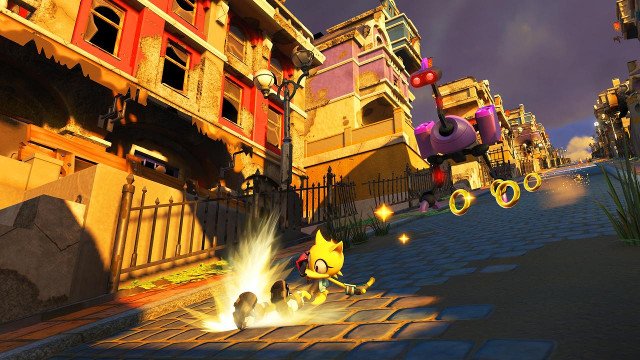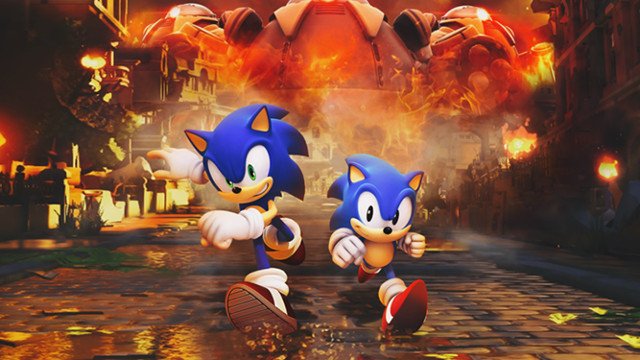Sonic Mania released last month to the highest reviews of any Sonic game in years with a current Metacritic score of 86. The game began as something of a fan concept from Christian “The Taxman” Whitehead, (the man behind the mobile ports of Sonic CD, Sonic the Hedgehog, and Sonic the Hedgehog 2) but ended as an official Sonic game fully backed by Sega. Intended to celebrate Sonic’s history, it plays as a true return to the blue blur’s roots and features a number of stages from the original trilogy plus a few new zones.
And then there’s Sonic Forces, which will be releasing on November 7th. While it obviously has not been seen in full yet, a decent amount of footage from multiple levels of the finished game is readily available, and its approach to Sonic gameplay has received a more controversial reaction than Mania’s old-school style. The game, rather than simply bringing Sonic back to his former 2D glory, has set its sights on the generally less successful 3D gameplay of the ‘Modern’ games, while also promising a return of the 2.5D Classic Sonic gameplay first introduced in Sonic Generations. Accompanying the two versions of Sonic will be a customizable character that fights with alien-powered weapons in a mixture of 2D and 3D gameplay.
Also: Sonic Forces Looks Pretty Slick, But So Did A Lot Of Sonic Games
The decisions being made for this main series Sonic game have been cause for some alarm, and not without reason; as was alluded to, 3D Sonic has historically been less well-received than his 2D counterpart, and a number of main series titles have suffered from a lack of focus. There are many fans who plan to buy the game on the day of release if they have not already preordered it, which is to be expected, but to some the red flags being raised by the game’s previews are far too prevalent to justify the purchase of a new release. Others are cautiously awaiting the arrival of official reviews and hoping for a pleasant surprise while expecting the worst. To see exactly why this is, it is important to take a comparative look at Sonic Mania and Sonic Forces within the context of the series that they mutually occupy.

As alluded to previously, Sonic has been plagued by a lack of focus in his main series games since the Genesis days. This began with Sonic Adventure for the Sega Dreamcast, where Sonic and five other characters — Tails, Knuckles, Amy Rose, E-102 Gamma, and Big the Cat — each had their own storylines to play through, culminating in the final boss which was fought as Super Sonic once all six individual stories were completed. The problem with this was that none of the alternate characters were as much fun to take control of as Sonic. Tails’ levels were decent but essentially just Sonic’s but with rings to fly through, Knuckles’ levels boiled down to playing hot and cold with a beeping gem, Amy’s levels were slow and dull, Gamma’s levels were weird shoot ‘em ups, and Big the Cat’s levels involved… fishing. In a Sonic game, for some reason.
Which, of course, took focus away from Sonic, who now only occupied 1/6 of his own game. Sonic Adventure 2 trimmed things down to only two playthroughs, but still included the gem hunting and shooting levels and included two characters for each style, meaning that Sonic’s style of fast-paced gameplay was still only featured in 1/3 of the game. Sonic Heroes had speed gameplay in every level but also required players to stop for slow combat and to go through four playthroughs of the same sets of levels with only minor changes across each to access its final boss. This style of split gameplay continued all the way up through Sonic Unleashed where one half of the game was a slow, repetitive beat ‘em up.
Fast forward nearly a decade to Sonic Mania, and it’s easy to see why the game was seen as a breath of fresh air for so many players. Finally a game was available that focused entirely on Sonic and the speedy precision platforming of his glory days without a bunch of extraneous play styles weighing it down. Sure, Tails and Knuckles were both playable alongside Sonic, but they mostly played the same with just enough variation in their movesets to add substantial variety without taking away from what made the game such a blast to run through in the first place. They felt like they fit in just like they did in Sonic 3 & Knuckles. Nobody was forced to slow to a crawl in order to play what amounted to a tech demo for Sega Bass Fishing for several hours in order to complete the game, and that was obviously good.
Because of this, Forces looks like it could be a step backwards even though it is technically piling on more types of content. Classic Sonic looks like he’s just there to be there as a holdover from Sonic Generations, and everything involving the customizable OC character screams ‘redundant’ since they play mostly like a slower Sonic with more interruptions in their level designs that break flow. It seems like the better decision would have been to refine the modern ‘boost’ gameplay that Forces boasts as its primary play style.

Speaking of which, Mania‘s gameplay is something that the series should really be focused on emulating and refining, even in 3D. Though it is true that the hedgehog hero’s levels have always been the best parts of his 3D games, it’s also true that even those segments have not done a particularly fantastic job of capturing what made the original games so darn enjoyable. In part, this is due to level design. Modern Sonic levels have always been relatively linear. This is strange because part of what made Sonic the Hedgehog such a revolutionary title was its branching, multi-tiered levels that rewarded lightning-quick reflexes while allowing for exploration and replay value. With most of the branches sheered off, the classics would begin to feel dull, and ironically it is the modern 3D titles that have suffered from this lack of freedom of movement far more than their supposedly flatter 2D counterparts.
Beyond this, the way Sonic moves itself needs some adjustments. Ever since Unleashed introduced boosting to the series back in 2008, so much of the games have been focused on automated spectacle that it can feel like the games are less like interactive pieces of media and more like movies that you occasionally offer input on. This might be a bit of a hyperbole of course, but it’s one that contains a kernel of truth. Holding down a button to instantly go fast and smash any enemies in your path to bits might seem like a fun idea at first, but it quickly reveals itself to be a shallow experience and after a while it becomes apparent that there’s not much else to be done. People often forget, but Sonic was never only about going fast; in the classic titles, speed was a reward for sustained successes in platforming, and it felt good because it was earned through careful interactions with the environment. Having it on demand cheapens that feeling of delayed reward and makes speed into something to have rather than something to experience.
Sonic Mania understood that both the level design and the way Sonic moves through it are both of equal importance. Sonic’s movements feed into the rollercoaster-like level design of the stages, enemies are placed carefully in order to challenge players rather than simply act as boost fodder, and even the new drop dash move sought to invent a new method of preserving momentum while rewarding players who analyzed the layout of the surreal worlds they were exploring to put the maneuver to its optimum usage.

Finally, Mania’s understanding of Sonic’s setting and tone are far more consistent than anything demonstrated in Forces. The classic titles were surreal and even when city-like settlements were seen in the backgrounds of stages, the environments that Sonic sprinted through were so absurdist and weird that the impossible loops and ramps found within them were easy to accept as normal in his universe. Ever since Adventure, however, this has become more difficult to swallow; the games have introduced realistic human beings, government institutions, and settlements, and so the surreal landscapes no longer fit as well. While Forces has seemingly abandoned human beings other than Eggman altogether (which is strange in and of itself seeing as they’ve been established as existing in Sonic’s world for years now) it still makes use of cities that appear to be intended to reflect more grounded civilizations. It is much more difficult to accept that a regular town would feature roads that would be impossible for the average citizen to navigate when the story appears to ask players to also accept that same place as a location that is fully livable by seemingly regular people, or regular animal people as the case may be.
Beyond this, Mania’s story was fun and simple while containing hidden depths; Knuckles, for instance, remembered and learned from his run-in with Mecha Sonic at the end of Sonic & Knuckles, but overall the tone was lighthearted just like in the classic games it was emulating. Forces, on the other hand, seems extremely confused about what kind of game it wants to be, which has been a problem especially since Adventure 2 introduced the realistic government military organization GUN with subplots involving accidental child murder and insanity-induced genocide attempts. Though said military operations seem absent in Forces, the game still seemingly can’t decide between being a cartoony romp and being a serious drama, and it navigates between the two poorly as a result. Green Hill Zone has supposedly been destroyed by Eggman’s activities, but it doesn’t look all that bad for the most part; in fact, it’s actually brighter in some areas than it was in Generations.
Eggman is supposed to be an overlord who rules over the entire planet, yet characters still treat him like an incompetent joke with canned snarking and all. The secondary villain Infinite has a musical theme that sounds like a cliched parody of Hollywood Undead but there’s no self awareness to it, and he spouts lines like “Torturing this wannabe hero doesn’t feel too bad” that sound like they are there simply as a transparent attempt to be edgy without really putting any thought into how that gels with the rest of the established universe.
Ultimately, the takeaway here is that regardless of what Forces ends up scoring on Metacritic or how it is received publicly, it has balance problems that the 3D Sonic games as a whole desperately needs to work out in order to advance to the next level of quality. Sonic Mania, the fan effort attempting to invoke games made 20 years ago- that’s two whole decades!- seemingly has a better understanding of what makes Sonic, well… Sonic. It seems as if Sega needs to take a look at what made Mania so well-received, and use that knowledge to improve their 3D output. This has been true for a long time now, but with Mania here now as a solid model, there is a better opportunity for this learning to actually take place than there ever has been previously. The Sonic series is at a crossroads with Mania and Forces representing two alternate approaches, and as a Sonic fan, one can only hope that Sega makes the right choice regarding which path they decide to travel down before it is too late.






